Outforia Quicktake: Key Takeaways
- Learning how to read a compass is essential for navigating the outdoors and finding your way to your destination.
- Understanding the different parts and features of a compass, such as the magnetic needle and orienting arrow, is crucial for accurate navigation.
- Adjusting for magnetic declination (the difference between magnetic north and true north) is critical for obtaining an accurate bearing.
- Compasses come in various types and models, such as base plate, lensatic, and digital compasses, each with their own features and uses.
- Practice and familiarity with your specific compass model will improve your compass reading skills and ensure successful navigation in the wilderness.

A compass is a trusty navigational tool used to help you find your way to your destination. You can learn how to read a compass by orienting a compass and adjusting its magnetic declination to get an accurate bearing.
Learning how to read a compass comes with some practice. When you use a compass, you’re using the Earth’s magnetic field to find magnetic north. Orienting a compass helps you find true north.
With some math skills and the help of the Earth’s magnetic field, you can navigate to your destination.
History of the Compass
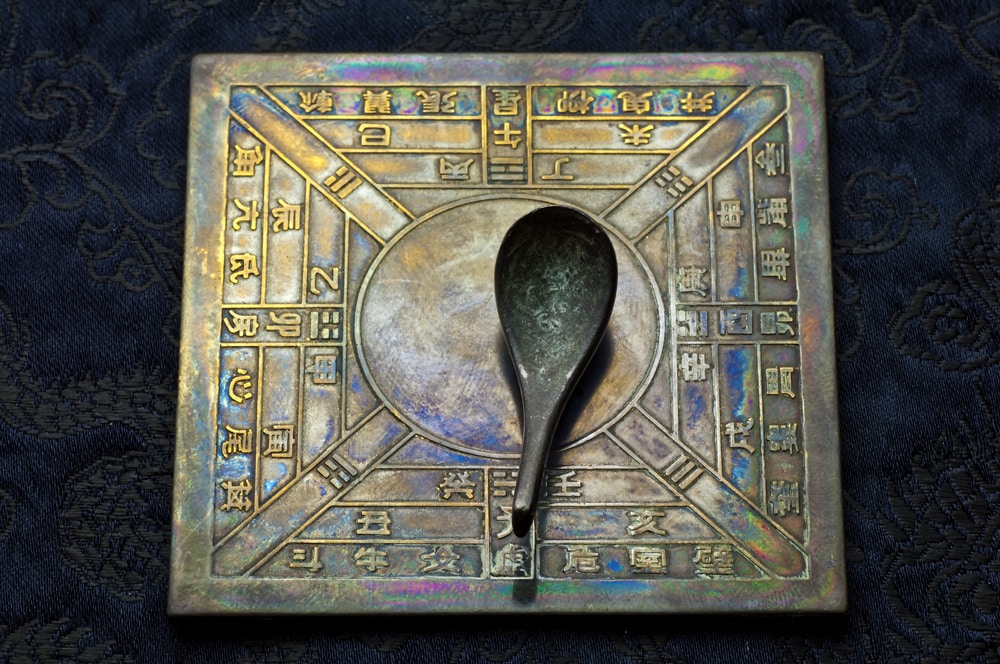
Compasses date back to thousands of years. Although not as reliable as the hi-tech compasses we have today, these tools still came in handy for early navigation. The compass dates back to the Chinese Han Dynasty sometime between 2nd Century BCE to 2nd century CE.
One of the oldest compasses from this period was a spoon-shape navigational tool made from a magnetic ore called lodestone.
The spoon was set on a bronze plate and used constellations as points of direction. The compass was called a south-pointer. The handle of the spoon pointed south and the plate had directional characters for north, south, east, and west.
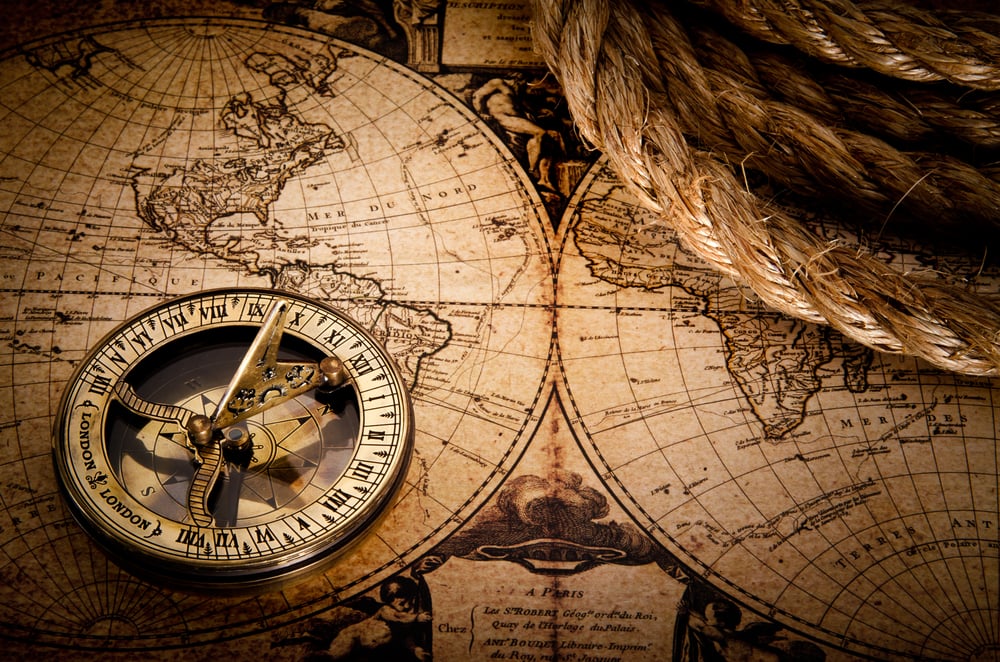
The magnetic compass didn’t come into the picture until the North Song Dynasty that ruled between 960 and 1127.
Chinese scholars realized that iron needles became magnetized with magnetite, which is a magnetic mineral. The compass was then placed in a bowl of water and would drift towards north. The lodestone, or magnetite, could also be used to point north by hanging it on a sting.
Sailors in the 13th century began using dry compasses. These compasses used a pivoting needle placed on a card in a wooden box. It resembled a rose which gave it the name rose compass.
More detailed compasses with additional directions, such as northeast or southwest, were created.
What is a Compass Used For?
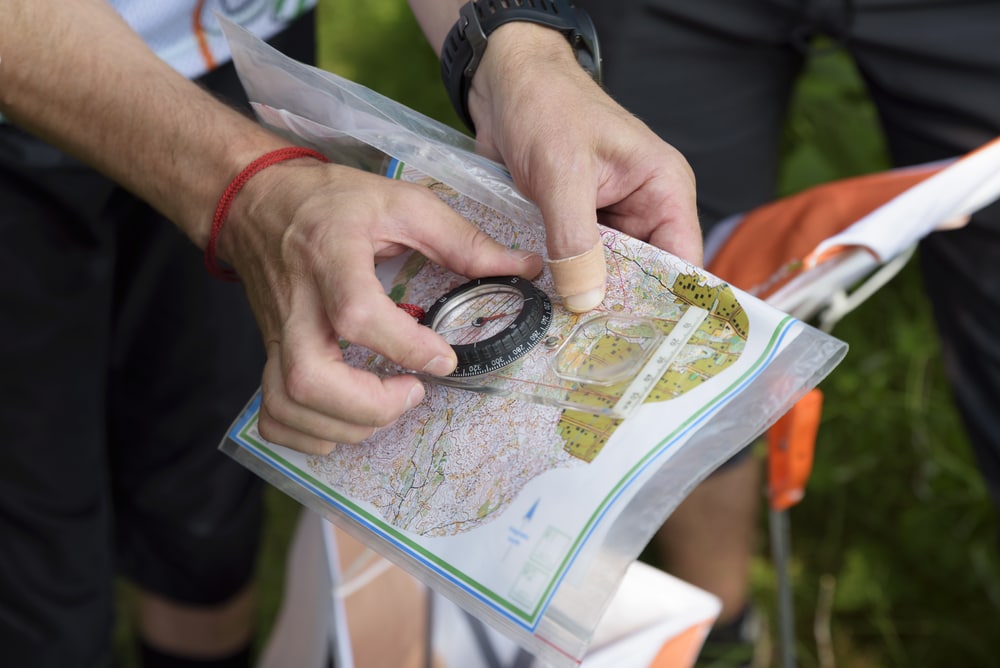
A compass can be used for many navigational purposes. You may use a compass by itself or with a map to determine landmark locations or plan a route to your destination.
A compass is commonly used to help people travel in the proper direction of their intended destination. It can also help you find your way back to the starting point.
The navigational tool can be used for various outdoor activities, such as hiking, camping, or skiing.
If your destination is out of sight, you can use a compass to plot points on a map. Intermediary objects you can see that align with your destination can be reached using your navigational tool.
If you want to know what an object or landmark is, you can use a compass and a map to figure it out. A compass can also come in handy if you need to communicate with someone who isn’t in your area by calculating the degrees of your location in relation to a landmark.
Parts of a Compass
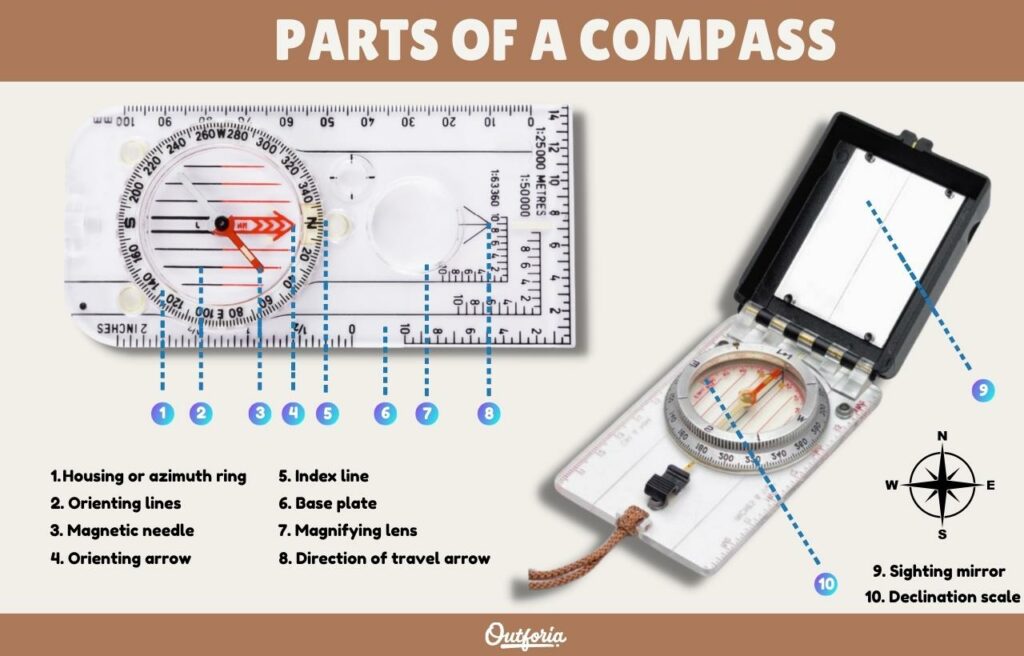
In order to know how to read a compass, it’s important to understand each part. Compasses have a number of features that all serve an important navigational purpose.
There are different types of compasses and models, which can have additional parts. We’re going to talk about the parts of a base plate compass. This is a basic compass that’s inexpensive, has standard features, and doesn’t need batteries to work.
- Magnetic needle: This is the pivoting needle of a compass, usually with a red tip, that always points to magnetic north.
- Orienting arrow: The orienting arrow is usually red or black and is used to align the magnetic needle when taking a bearing. It helps when you’re adjusting your compass according to magnetic declination.
- Housing or azimuth ring: This is the ring of a compass that includes degrees markings and cardinal points.
- Orienting lines: These lines lay parallel to the orienting arrow on a compass. They can be used to line up the grid lines of a map with the compass dial.
- Index line: This line is located on the outer part of the compass dial or azimuth ring above the north cardinal point. It helps you read the bearing you set.
- Base plate: This the platform that the compass is on. Base plates often include ruler markings to help measure map distances. Some compasses also have a protractor on the base plate for map measurements.
- Direction of travel arrow: This is the arrow located on the base plate of a compass that should be pointed in your desired destination or landmark.
- Magnifying lens: Most compasses have a magnifying lens to help you look at map features and landmarks easier.
- Declination adjustment screw: This is the screw located on the side or back of a compass. Simplistic compass models may not have this feature.
- Declination scale: The declination scale is on the azimuth ring or housing of a compass. These are all of the degree lines marked on the ring. These markings allow you to adjust your compass according to the angle of your direction or bearing.
- Clinometer: Some compasses come with a clinometer, which allows you to estimate the degrees of a slope or hill.
- Sighting mirror: Some compasses have a mirror that flips up at the top of the compass. This mirror can help you read your bearing more accurately by looking at the reflection of the dial and lining the bearing up with the line on top of the sighting mirror.
All of these nifty features on a compass should be used to get an accurate bearing. A bearing is the direction in which the compass points, either north or south, that’s measured by degrees.
Adjusting the Magnetic Declination of a Compass
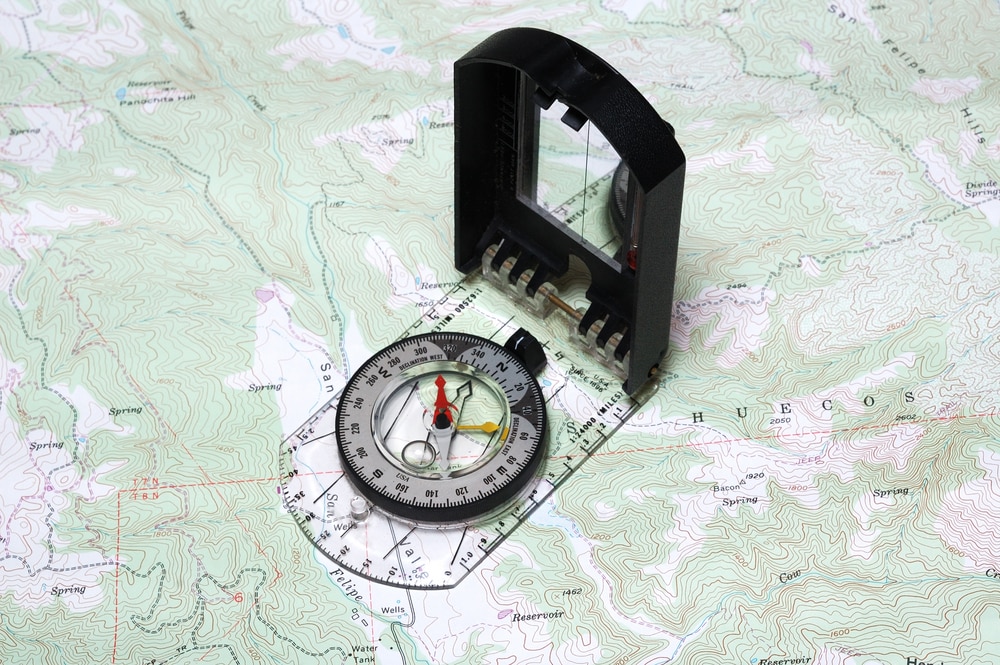
Now that you know the different features of a compass, you can start learning how to read one!
One of the first steps to learning how to read a compass is understanding the importance of magnetic declination.
The pivoting magnetic compass needle points toward magnetic north. However, topographic maps are drawn using true north, or the north pole. Magnetic declination can depend on geographic location. It can also change over time.
If you’re using an older topographic map, the declination may be different than a new map. Adjusting your compass’ magnetic declination is critical to receive an accurate bearing.
If the declination is off by just a single degree, it can throw off the accuracy of the bearing.
Your compass should come with an instruction manual that gives you specific details on how to adjust the declination based on your compass model.
Some models have a declination adjustment screw to set your compass to the proper declination. Other models may require the rotation of the azimuth ring to the proper declination degrees. The compass declination line should be moved the amount of degrees necessary to equal true north.
Calculating Easterly and Westerly Declination
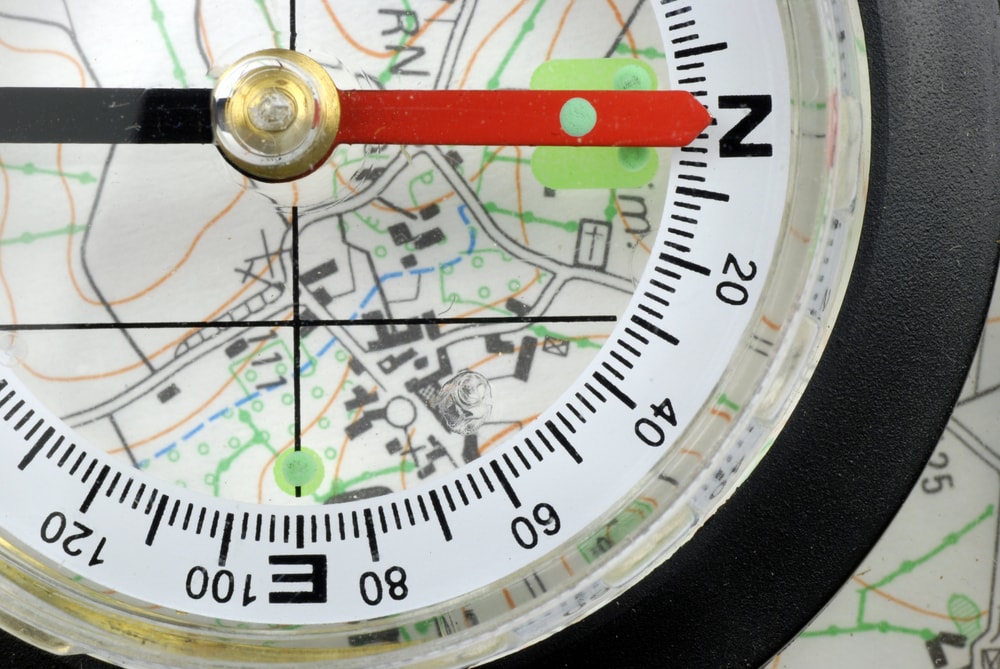
Magnetic declination for the United States ranges between 0 and 20 degrees. True north and magnetic north are the same for areas located along the zero declination line or agonic line.
The magnetic needle of a compass points east of true north when you’re west of the agonic line. If you’re east of the agonic line, the magnetic needle points west of true north. For example, Labrador, Maine has a magnetic declination of 20 degrees west. Alaska has a magnetic declination of 30 degrees east.
There’s some math involved for calculating magnetic declination. If you’re located west of the agonic line, it’s called easterly declination. If you’re east of the agonic line, it’s called westerly declination.
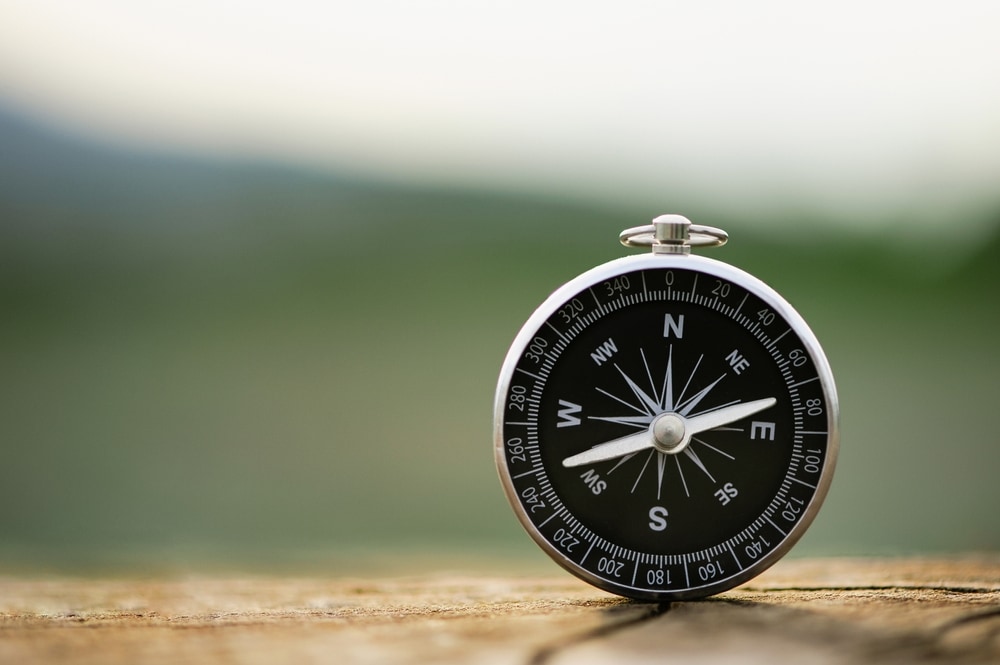
When calculating easterly declination, you subtract the true reading from easterly declination to receive the magnetic reading.
For westerly declination, you add the true reading with the westerly declination to receive the magnetic reading.
Here is a scenario that may help break down adjusting your compass to magnetic declination:
- You’re located in Labrador, Maine with a westerly declination of 20 degrees
- You’re facing the landmark you want to travel to
- The magnetic needle of your compass facing toward the landmark reads 25 degrees
- You subtract 25 degrees from 20 degrees west
- You get the true reading, which is 5 degrees
If you were located in an area with easterly declination, these numbers would be added together instead of subtracted.
The National Wildlife Coordinating Group provides some examples of calculating true readings from various locations.
Some electronic compasses may automatically adjust the magnetic declination. However, it’s important to double check if your compass is giving you accurate bearings.
You can also look up the magnetic declination of your area using the declination calculator on the National Centers for Environmental Information website.
You may also like: 5 Primary Types Of Maps Through The Ages (Pictures, History & Charts)
How to Read a Compass
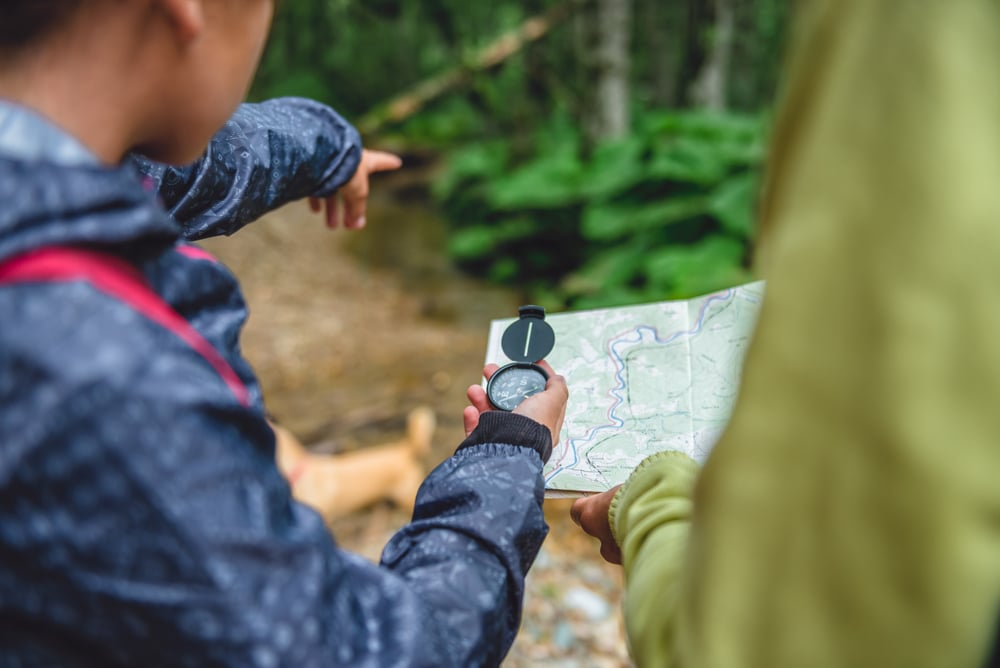
Once you’ve adjusted the compass for magnetic declination, it’s time to orient the compass to get an accurate bearing.
You can orient your compass by sight or using a map.
If you’re using a map, you can follow these steps to orient your compass with a map to get a bearing (or direction) of where you need to go:
- Make sure the compass is adjusted for magnetic declination
- Mark your current position and intended destination on the map
- Draw a straight line from your current position to your intended destination on the map
- Align the edge of the compass with the line you created on the map
- Rotate the azimuth ring until the orienting arrow and magnetic needle are aligned
- Pick up your map and compass
- Hold the compass at your waist in front of your body
- Turn your body until the magnetic needle and orienting needle are aligned
- Once aligned, the magnetic needle will be pointing toward your intended destination
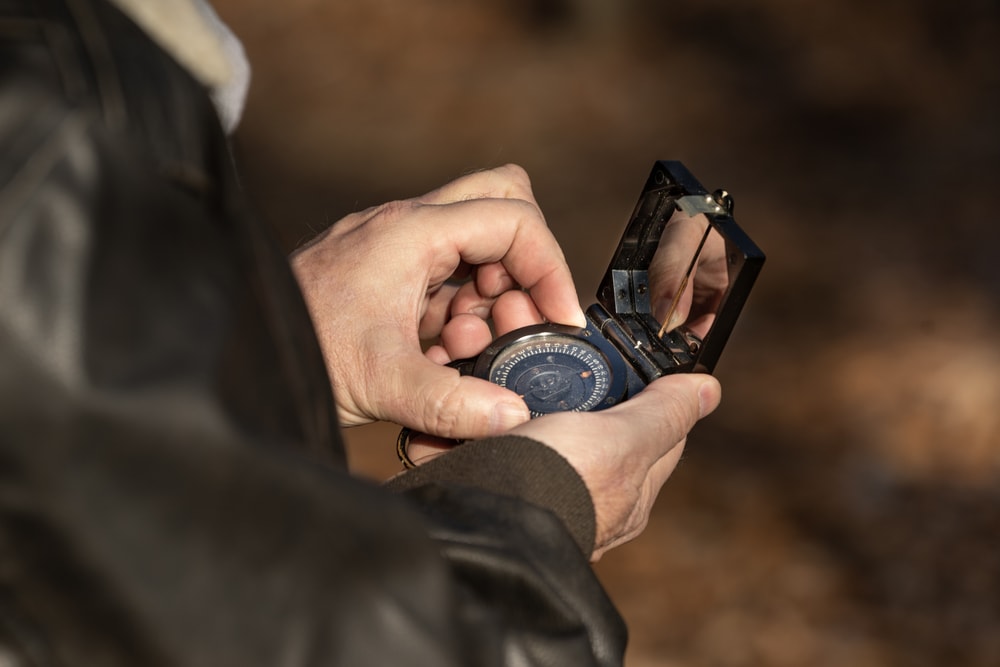
If you don’t have a map, you can still adjust your compass by using your sight. To figure out the proper direction toward your direction by sight, you can follow these steps:
- Face in the direction of your intended destination or landmark
- Point the direction of travel arrow at the landmark
- Line the orienting arrow up with the magnetic needle by rotating the azimuth ring
- Once aligned, the magnetic needle will be facing the direction toward your landmark
Adjusting your magnetic declination and orienting the compass properly is critical to getting an accurate bearing.
You may also like: 7 Must-Know Hiking Trail Signs
Tips to Get an Accurate Compass Reading
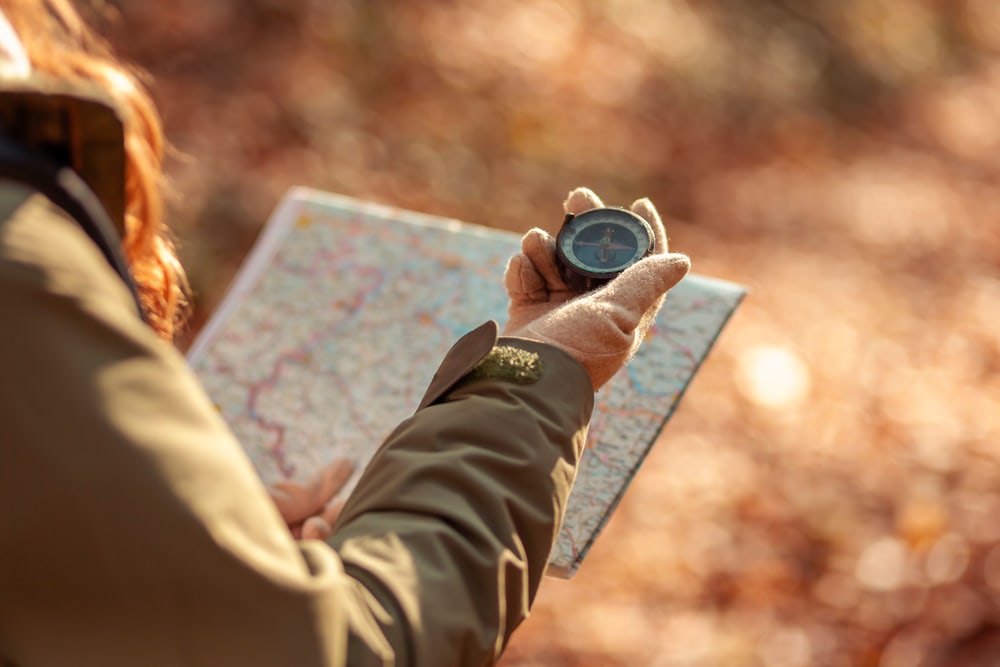
There are a few factors that can alter a compass reading, causing it to be inaccurate. Here are some tips to keep in mind when reading a compass:
- Hold the compass level at your waist.
- Try to keep your hand steady so the magnetic needle can move properly.
- Don’t move your head when taking a bearing. Only raise and lower your eyes.
- Keep the compass away from magnetic materials (such as metal from a vehicle, belt buckle, or clipboard).
- Double-check your bearing.
If you’re just learning how to use a compass, testing yourself to ensure your calculating magnetic declination and orienting your compass properly can be helpful. If you’re not fully comfortable using a compass, it shouldn’t be the only navigation tool you use.
Since compass models can vary, the process of adjusting the magnetic declination and orientation of a compass can be different than what’s been described. Be sure to read and follow the directions of the user manual that came with your compass.
You may also like: Smartphone Vs. Standalone GPS for Hiking
Types of Compass
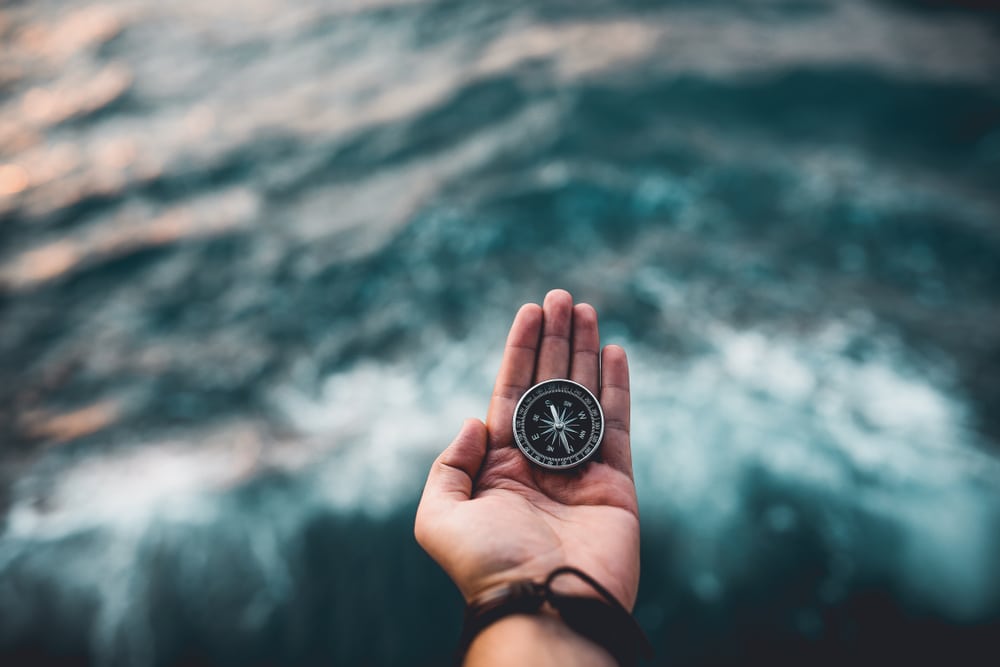
Features of the compass have changed and evolved over time. As humans have advanced, so have our tools. There are several different types of compasses with varying styles and features.
Basic compass models only have features that are essential to the main purpose of a compass: to determine location and help you navigate.
More advanced models have additional features that can measure slope angles or be used for other neat things.
With the digital age came the digital compass. Although these compasses may need batteries or require charging, it can make reading a compass a little easier.
Base Plate Compass
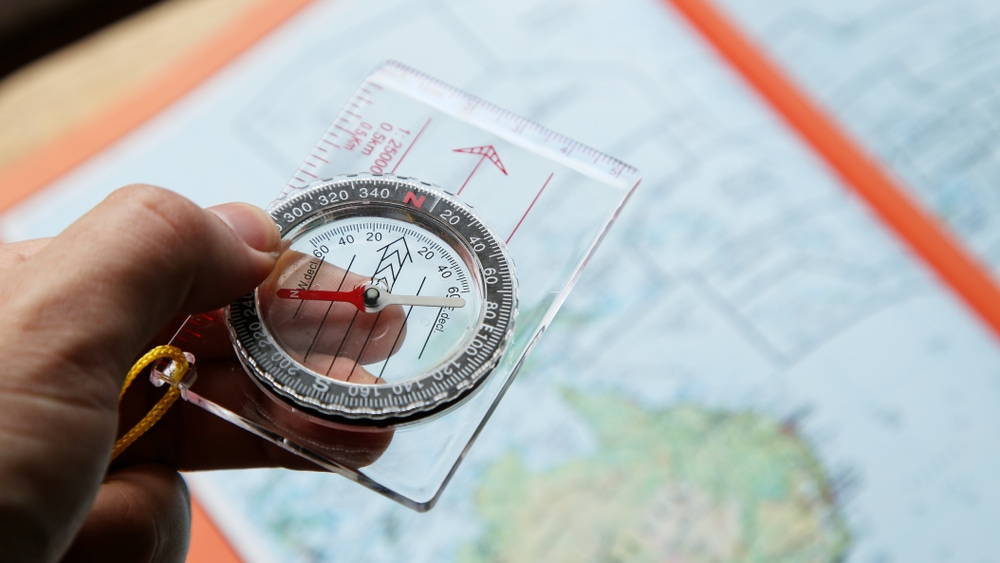
The base plate compass is a simplistic model that doesn’t require batteries. This compass has basic features and is great for beginners. Most standard base plate compasses have five essential features, including:
- Direction of travel arrow
- Index line
- Scales and rulers
- Housing
- Base plate
They may also come attached with a lanyard for easy carrying.
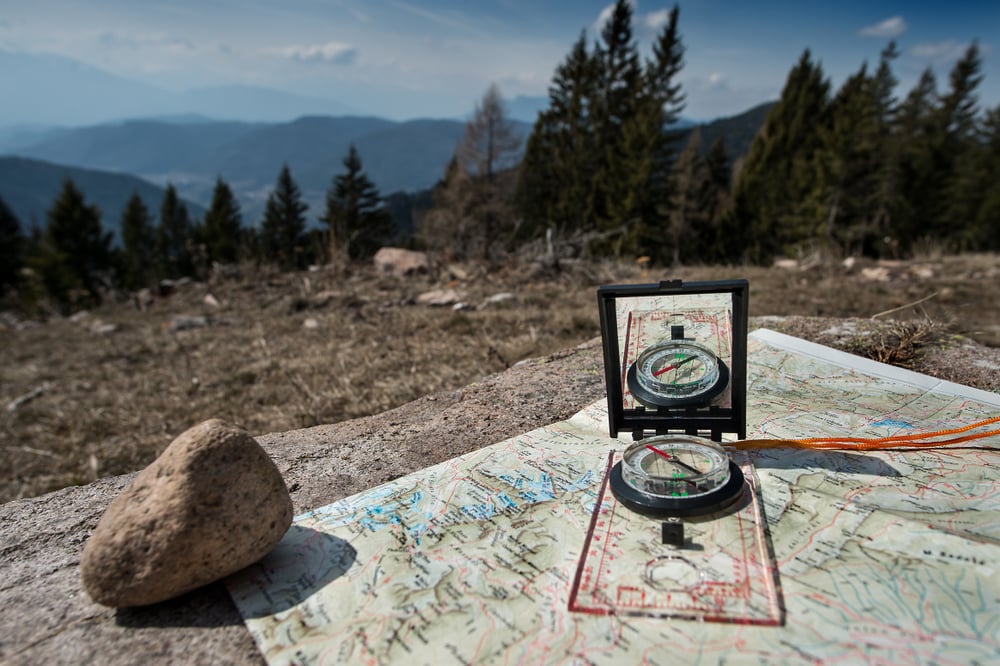
Another type of base plate compass is the mirrored base plate compass. This has the same features as a regular base plate compass, with the addition of a sighting mirror. They’re also called sighting compasses.
These compasses may have additional features that a regular base plate doesn’t have, such as a clinometer.
Lensatic Compass
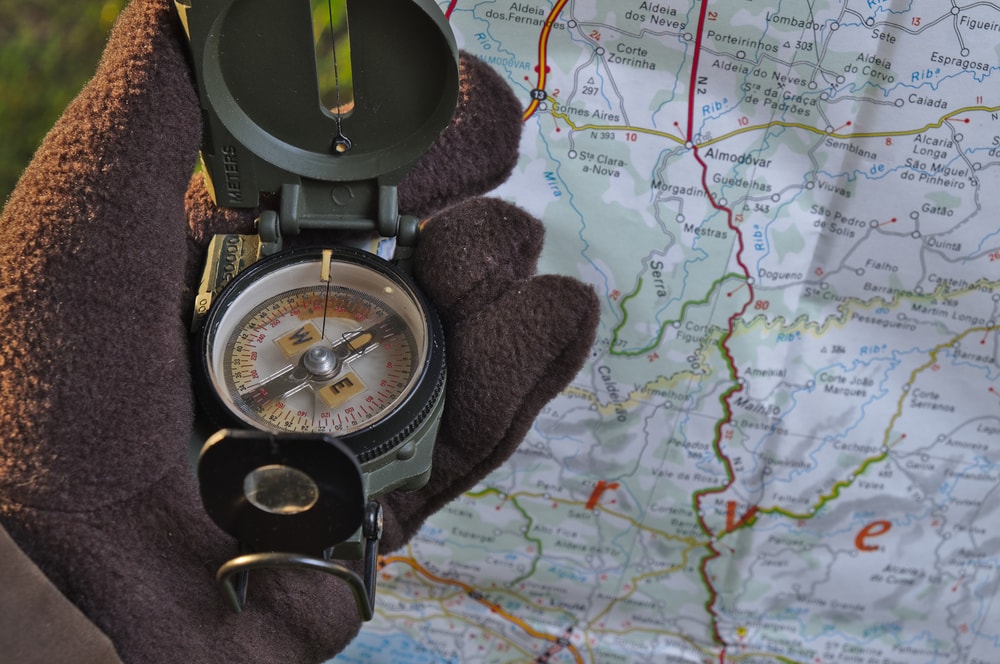
The lensatic compass has several additional parts compared to the base plate compass model. These compasses are also known as military compasses because they’ve been used by the US military.
Lensatic compasses have a lens on the back side of the compass. This lens is used for compass orientation. There are three main parts of a lensatic compass, including:
- Cover
- Base
- Reading lens
The base of a lensatic compass contains the common components of a standard compass. However, it includes a thumb ring. The thumb ring should be utilized when using a lensatic compass.
The cover looks like a lid that covers the base of the compass. It has an oblong oval cut out of the center with a sight wire in the middle.
The features of a lensatic compass are designed to help you get a more accurate bearing.
Using the additional features, such as the cover with the sight wire and thumb ring are optional. The additional features can be moved out of the way to use it as you would a standard compass.
Digital or Electronic Compass
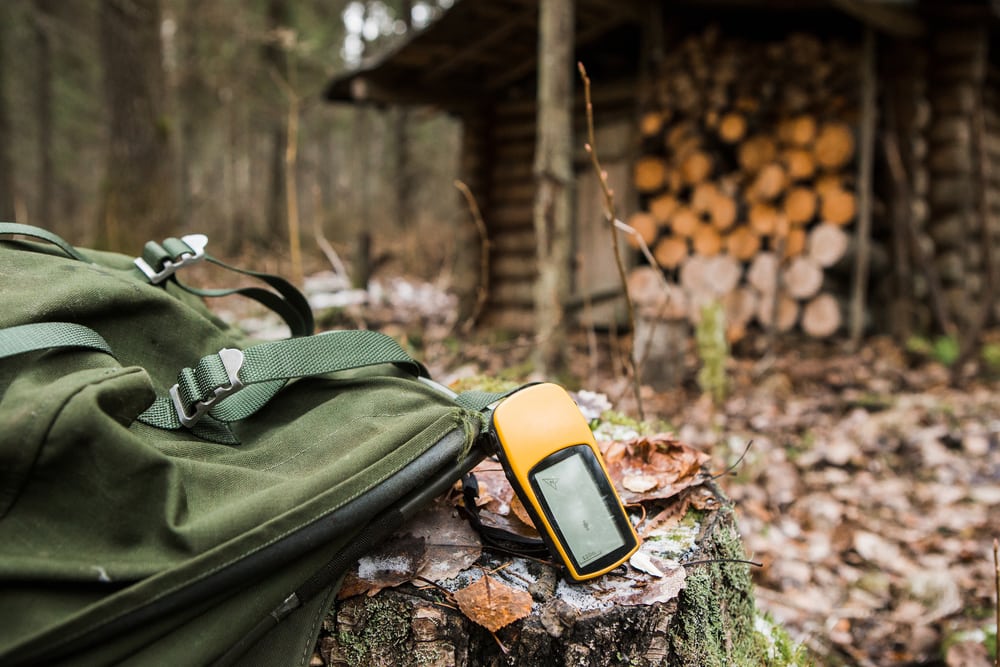
Digital or electronic compasses operate differently than standard compasses. This compass detects the Earth’s magnetic field just as a standard compass, but it does so through technology.
The technology used is referred to as magneto-inductive. While detecting the Earth’s magnetic field, it also distinguishes it from other magnetic materials.
Errors with magnetic distortion can still occur. Likelihood of error can depend on how strong an object’s magnetic field is and its relative location to the compass.
There are a wide range of digital compasses, so magnetic declination adjustments can vary. You may find specific directions for adjusting the magnetic declination of a digital compass in the model’s instruction manual.
You may also like: Ultimate Camping Checklist – Complete Guide To Everything You’ll Need + Printable PDF
Compass FAQs
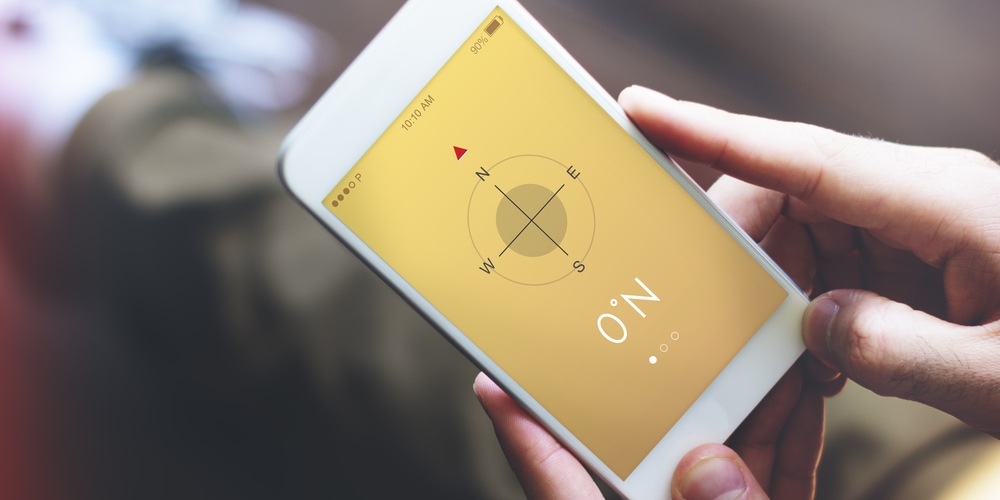
Are smartphones or watch compasses reliable?
The reliability of smartphone and watch compasses is still up for debate. These versions of digital compasses shouldn’t be the only thing you rely on to navigate.
Phones and watches use a magnetometer and other sensors to give you a reading. It doesn’t work like a normal compass because a phone or watch has magnetic materials in it.
The readings for these compasses aren’t always accurate and until they’re proven to be reliable, they shouldn’t be depended on as such.
What can mess up a compass?
Magnetic fields from objects made of metal and other magnetic materials can mess up a compass. Since magnetic compasses detect the Earth’s magnetic field, other objects with magnetic fields can offset the compass.
Holding a compass improperly can also cause inaccurate readings. Additional factors that can cause errors include miscalculation of declination and improper compass orientation to true north.
How do you know if a compass is working?
Looking at the movement of the magnetic needle can help you determine if a compass is working. When oriented properly, the magnetic needle should point toward the true north.
If the needle isn’t moving in accordance with your turns, this is a sign it isn’t working.
What do the numbers mean on a compass?
The numbers on a compass dial signify degrees. The numbers go from 0 degrees to 360 degrees. Truth north sits at 0 degrees.
Each cardinal point is 90 degrees apart. East is 90 degrees, south is 180 degrees, and west is 270 degrees. These numbers are important when calculating magnetic declination.
What is the best type of compass?
The wide range of uses and features a compass offers can give you different answers to this question. If you plan on using your compass for a specific outdoor activity, you might consider certain features.
It’s ultimately up to your personal opinion based on the different features you like.
Skiers and mountain climbers may want a sighting compass with a clinometer to calculate slope angles. The US military prefers using the lensatic compass. Beginners may like the simplistic features of a base plate model.
What can a clinometer be used for?
A clinometer is used to measure slopes, including height and distance. This compass feature can be useful for determining avalanche hazards. Clinometers are also used by surveying professionals and other field researchers.









